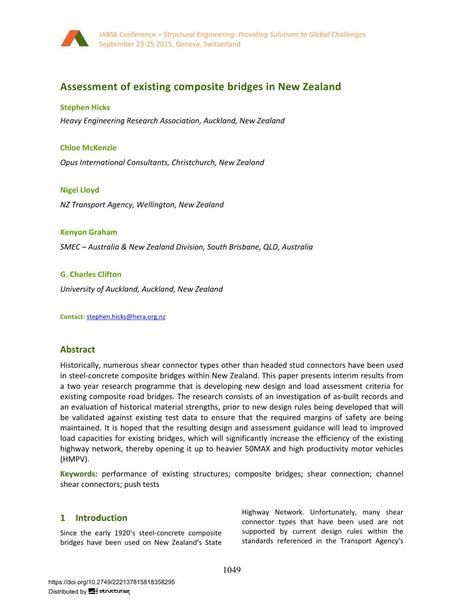Assessment of existing composite bridges in New Zealand

|
|
|||||||||||
Bibliografische Angaben
| Autor(en): |
Stephen Hicks
(Heavy Engineering Research Association, Auckland, New Zealand)
Chloe McKenzie (Opus International Consultants, Christchurch, New Zealand) Nigel Lloyd (NZ Transport Agency, Wellington, New Zealand) Kenyon Graham (SMEC – Australia & New Zealand Division, South Brisbane, QLD, Australia) G. Charles Clifton (University of Auckland, Auckland, New Zealand) |
||||
|---|---|---|---|---|---|
| Medium: | Tagungsbeitrag | ||||
| Sprache(n): | Englisch | ||||
| Tagung: | IABSE Conference: Structural Engineering: Providing Solutions to Global Challenges, Geneva, Switzerland, September 2015 | ||||
| Veröffentlicht in: | IABSE Conference Geneva 2015 | ||||
|
|||||
| Seite(n): | 1049-1055 | ||||
| Anzahl der Seiten (im PDF): | 7 | ||||
| Jahr: | 2015 | ||||
| DOI: | 10.2749/222137815818358295 | ||||
| Abstrakt: |
Historically, numerous shear connector types other than headed stud connectors have been used in steel-concrete composite bridges within New Zealand. This paper presents interim results from a two year research programme that is developing new design and load assessment criteria for existing composite road bridges. The research consists of an investigation of as-built records and an evaluation of historical material strengths, prior to new design rules being developed that will be validated against existing test data to ensure that the required margins of safety are being maintained. It is hoped that the resulting design and assessment guidance will lead to improved load capacities for existing bridges, which will significantly increase the efficiency of the existing highway network, thereby opening it up to heavier 50MAX and high productivity motor vehicles (HMPV). |
||||
| Stichwörter: |
Verbundbrücken Schubverbindung
|
||||

